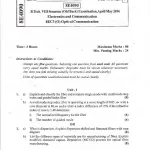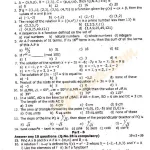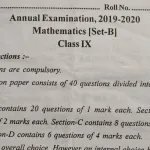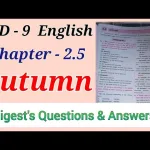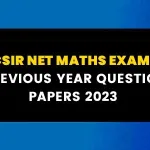Where did the inauguration ceremony take place?
The ceremony was held in the amphitheatre formed by the Union Buildings in Pretoria.
Why is 10 May considered an ‘autumn day’ in South Africa?
In South Africa, which is in the Southern Hemisphere, May falls in the autumn season.
What does Mandela mean by ‘an extraordinary human disaster’?
He refers to the apartheid system that caused immense suffering to the black population.
What is the ‘glorious human achievement’ mentioned by Mandela?
The establishment of South Africa’s first democratic, non-racial government.
Why did Mandela thank international leaders during his speech?
For their support and presence at the inauguration, symbolizing global solidarity.
What ideals did Mandela set for South Africa’s future?
A nation free from poverty, discrimination, and injustice.
How did the military generals’ attitude change towards Mandela?
They saluted him, showing respect, contrasting their previous role in enforcing apartheid.
Why were two national anthems sung at the ceremony?
To honor both black and white communities, symbolizing unity.
How does Mandela describe the government systems in the 20th century?
Initially oppressive under apartheid; later transformed into a democracy recognizing all citizens’ rights.
What does courage mean to Mandela?
It is not the absence of fear but the triumph over it.
Does Mandela believe love or hate is more natural to humans?
He believes love comes more naturally to the human heart than hate.
What are the ‘twin obligations’ Mandela mentions?
Obligations to one’s family and to one’s community and country.
What did freedom mean to Mandela as a boy?
Being able to enjoy life without restrictions.
How did Mandela’s understanding of freedom evolve?
He realized true freedom includes the ability to fulfill responsibilities to family and society.
Does Mandela think the oppressor is free?
No, because oppressors are also imprisoned by hatred and prejudice.
Why did many international leaders attend the inauguration?
To show support for South Africa’s transition to democracy.
What does Mandela mean by being ‘the sum of all those African patriots’?
He acknowledges that his achievements are due to the efforts of those who fought before him.
How does oppression create ‘heights of character’?
It brings out resilience and strength in those who are oppressed.
What is Mandela’s view on humanity’s greatest wealth?
He believes the people are the greatest wealth of a nation.
How did apartheid affect South Africa?
It caused deep divisions and suffering among its people.
What changes occurred in South Africa’s government by the end of the 20th century?
The oppressive apartheid regime was replaced by a democratic government.
How did Mandela’s imprisonment impact his views?
It strengthened his resolve and belief in human dignity.
What role did Mandela’s daughter play during the inauguration?
She accompanied him, symbolizing family support.
What is the significance of the Union Buildings?
They are the seat of the South African government and symbolized the new era.
How did Mandela’s early life influence his activism?
Experiencing racial injustice firsthand motivated him to fight for equality.
What message does Mandela convey about reconciliation?
That forgiveness and unity are essential for nation-building.
How did the international community view South Africa post-apartheid?
With renewed respect and as a symbol of peaceful transition.
What does Mandela say about the role of education?
Education is a powerful tool to change the world.
How did Mandela’s leadership style differ from previous regimes?
He emphasized inclusivity, dialogue, and reconciliation.
What challenges did Mandela face upon becoming president?
Uniting a divided nation and addressing economic disparities.
How does Mandela define ‘true freedom’?
The ability to live with dignity and equal rights.
What is the importance of the ‘Long Walk to Freedom’ title?
It signifies the prolonged struggle against apartheid.
How did Mandela’s imprisonment conditions reflect apartheid’s cruelty?
He faced harsh treatment, symbolizing the broader oppression of black South Africans.
What role did international sanctions play in ending apartheid?
They pressured the South African government to reform.
How did Mandela’s release from prison impact the nation?
It marked a turning point towards democracy and reconciliation.
What is Mandela’s vision for South Africa’s youth?
To be educated, empowered, and active in nation-building.
How does Mandela address the issue of poverty?
He emphasizes the need to eradicate poverty for true freedom.
What is the significance of the phrase ‘never, never and never again’?
A pledge that South Africa will not return to oppression.
How did Mandela’s leadership influence global movements?
He became a symbol of resistance and reconciliation worldwide.
What does Mandela say about the importance of unity?
Unity is essential for national progress and healing.
How did Mandela’s personal sacrifices contribute to the nation’s freedom?
His willingness to endure hardship inspired others to continue the struggle.
Top Indian Books for Nelson Mandela Class 10 Questions and Answers
1. Nelson Mandela – Class 10 Guidebook
Author: R.K. Sharma
Publication: Evergreen Publications
Content: Includes chapter-wise summaries, long and short answer questions, grammar practice, and value-based questions with easy explanations.
2. Nelson Mandela Chapter Companion for Class 10
Author: Meera Sethi
Publication: Oswal Publishers
Content: Focuses on character sketches, NCERT-style questions, thematic discussions, and HOTS (Higher Order Thinking Skills) based questions.
3. English Literature – Nelson Mandela Chapter Insights
Author: Anjali Verma
Publication: Full Marks
Content: Detailed annotations, vocabulary aids, objective-type questions, and extract-based MCQs designed for board exam practice.
4. Understanding Nelson Mandela – Class 10 English
Author: Sanjay Narayan
Publication: Dhanpat Rai & Co.
Content: Explanation of literary devices, key quote analysis, short questions with model answers, and previous year board question trends.
5. Learn With Solutions: Nelson Mandela Class 10
Author: Pooja Anand
Publication: Arihant Publications
Content: Includes solved NCERT exercises, additional practice questions, chapter tests, and critical thinking exercises.
6. Complete Chapterwise Guide – Nelson Mandela
Author: Ravi Gupta
Publication: Educart
Content: Contains topic-wise questions, assertion-reason questions, sample answer formats, and quick revision tools.
7. Smart Study Nelson Mandela – Class 10 English
Author: Deepali Malhotra
Publication: MTG Learning
Content: MCQs, short and long answer writing skills, sample board-style papers, and theme-based analysis.
8. NCERT Companion – Nelson Mandela Explained
Author: Sneha Bhatia
Publication: Target Publications
Content: Paragraph explanations, grammar-based questions from the chapter, map of themes, and competency-based practice.
9. Ace Your Exams – Nelson Mandela Class 10
Author: Ritu Sharma
Publication: Scholar’s Hub
Content: Highlights important quotes with meanings, in-text questions with sample answers, and poetic device explanations.
10. Literature Lens: Nelson Mandela and Other Stories
Author: Vandana Mehta
Publication: MBD Group
Content: Visual organizers, thinking maps, contextual reading questions, and literature values for board exam focus.
11. Exam Ready – Nelson Mandela Class 10 English
Author: Abhishek Jain
Publication: VK Global
Content: Practice sheets, detailed answers, marks-weightage analysis, and conceptual breakdown of key ideas.
12. Insight Series – Nelson Mandela and Literary Pieces
Author: Priya Raghavan
Publication: Xam Idea
Content: A mix of reading comprehension, extract interpretation, and answer writing techniques with value-based inputs.
13. Success Path – Class 10 Nelson Mandela Guide
Author: Sweta Kumari
Publication: Pitambar Publishing
Content: Chapter outline, character motivations, inferential reasoning questions, and real-life application discussions.
14. Perfect 10 – English Reader Nelson Mandela Chapter
Author: Amit Soni
Publication: Jagran Josh Publications
Content: Model board questions, sample answer keys, question bank, and mind-map summaries.
15. English 360 – Nelson Mandela & Literature
Author: Simran Tiwari
Publication: Rachna Sagar
Content: Mixed format Q&A including fill in the blanks, sentence correction, and literary element analysis.
16. Value Booster – Nelson Mandela for CBSE 10
Author: Rashmi Joshi
Publication: Learnwell Books
Content: Focus on value-based questions, ethical insights, life lessons, and citizenship-based discussion questions.
17. Scoring Solutions – Nelson Mandela Explained
Author: Rajeev Tandon
Publication: S Chand
Content: Topper’s answer examples, in-text solutions, theme interpretations, and exam-oriented tips.
18. My Learning Companion – Class 10 Nelson Mandela
Author: Harshita Kapoor
Publication: Saraswati House
Content: Diagrams, chapter flowcharts, concept-building questions, and application-based learning.
19. Smart Learner’s English – Nelson Mandela Special
Author: Anil Jha
Publication: Goyal Brothers Prakashan
Content: Critical appreciation, tone and mood analysis, vocabulary tests, and discussion prompts.
20. Brain Booster for English – Nelson Mandela Chapter
Author: Sunita Rao
Publication: Blue Rose Publishers
Content: Summary with commentary, long-form answers with points breakdown, and practice worksheets.
Nelson Mandela Class 10 Questions and Answers – Expert Insights for Success
The chapter “Nelson Mandela: Long Walk to Freedom” from Class 10 English is not just a lesson in history—it’s a powerful narrative about struggle, courage, and justice. Understanding this chapter thoroughly is essential for students aiming to score well in their board exams. This article offers expert guidance on how to approach Nelson Mandela Class 10 questions and answers, making preparation smarter and easier.
The chapter is based on the autobiography of Nelson Mandela and focuses on South Africa’s transition from apartheid to democracy. It presents deep themes such as the cost of freedom, personal sacrifice, equality, and reconciliation. The key to mastering this chapter lies in breaking it down into meaningful segments and preparing for all types of questions—short answers, long answers, and extract-based comprehension.
One of the most common mistakes students make is memorizing answers without understanding the central ideas. Instead, experts recommend reading the chapter closely, identifying major events, and understanding Mandela’s feelings during the inauguration. This builds a strong foundation for answering both direct and inferential questions.
Short answer questions often focus on specific events like the inauguration day, Mandela’s early life, or the meaning of freedom. Practice answering these in 30–50 words to keep responses concise. For instance, questions like “What does Mandela mean by ‘the greatest wealth of a nation’?” or “Why were two national anthems sung?” require factual clarity and a focused answer.
Long answer questions demand deeper analysis. These might include questions like “Explain the twin obligations Mandela mentions” or “How did Mandela’s idea of freedom change over time?” Here, students should present structured responses using clear points, transition words, and supporting examples from the text.
Extract-based questions are increasingly common in the CBSE board exams. These questions assess a student’s comprehension and ability to analyze a short passage. To prepare, read sample extracts from the chapter and practice identifying tone, message, and literary devices.
Vocabulary-based questions are also important. Students should be familiar with terms like “apartheid,” “autocracy,” “twin obligations,” and “profound.” Teachers suggest creating a glossary while reading the chapter to enhance both comprehension and expression in answers.
Using value-based questions is another effective method to deepen understanding. For example, questions like “What values do you learn from Nelson Mandela’s life?” allow students to express their personal reflections while staying aligned with the text.
To revise effectively, solve sample papers and practice worksheets focused solely on this chapter. Discussing questions in study groups and reviewing answer formats used in previous board exams can further strengthen exam readiness.
By approaching Nelson Mandela Class 10 questions and answers with this strategic mindset, students can improve both their writing quality and their understanding of one of the most inspiring figures in modern history.
FAQ for Nelson Mandela Class 10 Questions and Answers
What is the best way to study Nelson Mandela’s chapter for Class 10?
Read the chapter in parts, summarize each section, and practice writing answers in your own words to improve clarity and retention.
What types of questions are asked from the Nelson Mandela chapter in board exams?
Expect short answer questions, long answer questions, extract-based comprehension, and value-based questions.
How can I improve my answers for this chapter?
Use clear language, quote key phrases, and structure your answers with an introduction, body, and conclusion when needed.
Are there any important themes to focus on?
Yes, focus on freedom, sacrifice, courage, racism, equality, and reconciliation as central themes.
How many marks does this chapter usually carry?
It typically carries around 6 to 8 marks in total, including reading comprehension and writing-based questions.
What is the significance of Mandela’s ‘twin obligations’?
They represent the responsibility one has towards their family and their nation, a recurring theme in the chapter.
Should I memorize the textbook answers?
No, understanding the chapter and practicing answer writing is more effective than rote memorization.
How to deal with extract-based questions from this chapter?
Read the given extract carefully, identify the context, and relate it to the overall theme while answering.
Can this chapter appear in both Section A and Section B of the paper?
Yes, it can appear as part of the Reading or Literature section depending on the question format.
What literary devices are used in the chapter?
You’ll find metaphors, imagery, symbolism, and personification. Understanding these helps in answering analytical questions.
Latest Posts
- Step-by-step guide to download and apply for jee mains admit card 202
- Comprehensive 2025 government holidays and recruitment details for job seekers
- JEE Mains Admit Card 2025: Your Step-by-Step Guide to Downloading the Hall Ticket
- Everything You Need to Know About 2025 Government Holidays Recruitment
- Comprehensive Guide to rrb d group recruitment 2025 – Eligibility, Vacancies, and Application
- Detailed guide to nps trust recruitment 2025 vacancies, eligibility and apply process
- Comprehensive guide to hpcl recruitment 2025 notification, vacancies, and application process
- ignou bed admission 2025 complete recruitment guide with eligibility and process
- Comprehensive Guide to Indian Army Agniveer Recruitment 2025 Notification and Jobs
- Everything You Must Know About CBSE Board Exams 2025 Changes & New Rules


